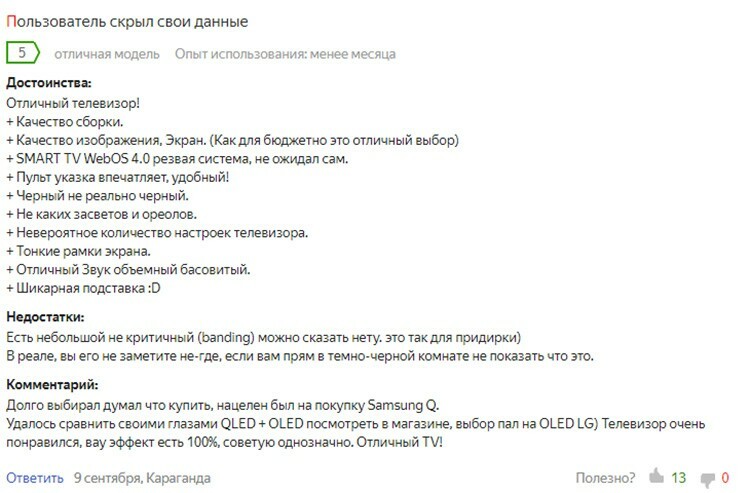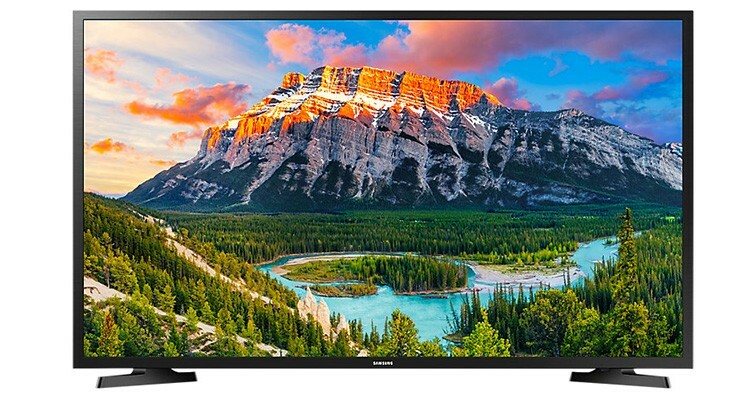
CONTENT
- 1 What is QLED technology
- 2 OLED TVs - what is it by technology
- 3 What is LED technology
- 4 What is IPS technology
- 5 QLED, OLED or LED - which is better?
- 6 How Much Does LED, IPS, OLED and QLED TV Cost - A Small Price Review
What is QLED technology
In fact, QLED is a marketing name rather than something innovative. At the heart, as with all LCD TVs, is the backlight technology using LEDs. It's just implemented in a special way. In general, the term QLED was introduced by Samsung as a description of a new method of backlighting screens. At the same time, the exact same technology, only from LG, is called Nano Cell.
The peculiarity of QLED is that each pixel emits its own color, and does not form it from mixing several basic ones. This is accomplished by transistors, the dimensions of which do not exceed a few nanometers. Despite the breakthrough, QLED has a number of problems. First, the pixels still have to be highlighted. Secondly, the brightness of the displays gradually decreases after about 10,000 hours of operation.
OLED TVs - what is it by technology
This is a completely new type of LED that is actively used in displays. The technology is based on the ability of a multilayer polymer film to glow under the influence of current. In fact, this is the main difference between LED and OLED TVs.

The main advantages of the technology are considered to be increased brightness, high contrast and low power consumption. At the same time, there are drawbacks, which at this stage are still rather shortcomings of the new technology. Firstly, some colors lose their brightness earlier than others - reliable screens cannot be created yet. Secondly, since the technology is new, its incompleteness is still noticeable, and therefore it is very expensive to manufacture.
What is LED technology
The abbreviation LED itself stands for light-emitting diode or "light-emitting diode". These diodes began to be used to illuminate LCD screens. Implementation is possible in two ways: in the form of strips of diodes along the edges of the screen or in the form of a matrix over the entire area of the screen.

The second approach uses RGB diodes to illuminate specific colors. There is also an abbreviation WLED, which means "white LEDs" and also looks more like a marketing name. WLED or LED displays work on the same principle.
What is IPS technology
IPS technology is a type of matrix used in displays. One of its important advantages is large viewing angles, which TN matrices could not boast of.

Also, IPS more fully reproduces the color depth. Companies Lg, Hitachi and NEC are constantly improving and developing IPS. Therefore, there is a whole mass of modifications of this technology - with their own designations and nuances.
QLED, OLED or LED - which is better?
Comparison of all three types of backlighting is best done according to certain criteria. Therefore, we will analyze the differences between LED, OLED and QLED LCD displays in different categories.
By response time
Any dynamic object on the screen leaves behind a trail, which is formed due to the fact that each pixel must have time to change color. The shorter the response time (the rate at which a pixel changes color), the smaller the trail will be, and the picture will look more coherent.
OLED is undoubtedly the leader here. Since the pixels themselves are the source of color and light, they change almost instantly. The response time in OLED can be as high as 0.1ms. QLED is inferior in this regard. Since the pixel backlighting in this technology is still implemented by separate diodes, there is also an overhead of controlling the drivers and backlighting. LED remains behind everyone.
In general, manufacturers of modern TVs try to solve such problems with additional tweaks and software tools. So sometimes a good quality LED TV can show excellent results, approaching QLED.
The difference between QLED, OLED and LED in terms of brightness
Comparing the brightness of the three technologies is a very subjective matter. Different display models can implement brightness levels in different ways, up to software methods. However, conclusions can be drawn based on the technologies themselves.
OLED can produce the highest brightness of any backlighting method available today. However, brightness is the main criterion for screen uptime. The higher the brightness, the less it will last. Therefore, in order to find the perfect balance between durability and brightness, it is artificially adjusted in such displays. Plus, OLED devices deliver the best contrast, and the white-to-black ratio can be adjusted with deeper blacks.
LED and QLED LEDs have little or no difference in brightness. The fact is that both types are based on the same LED backlighting mechanism. Another thing is that QLED TVs are simply more technologically advanced and use many new technologies to implement brightness enhancement.
Contrast and Black Depth
These two parameters will be the highest for OLED TVs. What does it mean? Their contrast is almost endless. This means that the black color on the displays looks the most real. Due to the fact that each pixel has its own color and glows by itself, adjusting the contrast for OLED is not a problem at all.
QLED and LED have much less contrast. Here, the very technique of highlighting pixels in blocks or segments imposes a limitation. Naturally, it will be difficult to obtain a sharp transition from white to black in neighboring areas.
By color gamut
Determining the best color gamut is also not an easy task. Display models with HDR on board practically eliminate the difference between natural high color rendering and its implementation using this technology. For example, QLED TVs have multi-HDR on almost all models. But on OLED versions - not everywhere. That is, the color rendition is formed there naturally, and, in fact, OLEDs provide more realistic colors. In conventional LED models, color rendition depends on the presence of HDR.
Viewing angles
OLED displays have the most maximum viewing angles. Since the diodes are essentially the matrix itself, when changing the viewing angle, there is no color distortion and image shading. QLEDs, if they are based on IPS matrices, also show very good results. LED displays can sometimes still be implemented on TN matrices with not the greatest viewing angles.
QLED vs OLED vs LED - Energy Efficiency Comparison
On average, all three technologies have approximately the same power consumption. They just spend it a little differently. OLED TVs consume energy per pixel. How much it consumes depends on its brightness. In LED technology, all consumption is spent on providing the backlight. This also includes control of controllers, drivers and diodes directly. Smart TV systems reduce power consumption slightly depending on the environment through an adaptive brightness control system. Therefore, all three technologies do not have much difference in energy consumption.
QLED, OLED and LED lifespan
OLED immediately looks like an outsider in this category. Due to the cost of technology, pixels lose their former brightness within 2-3 years. Moreover, the more intense the brightness, the faster it happens. QLED and LED screens (more precisely, matrices) can work for a very long time. The only thing that can fail is electronics and peripherals, which ensure the operation of the electrical circuit or individual components.
The bottom line: which technology is cooler
There is no doubt that the innovative OLED is superior in many respects to any of the representatives of the LED segment, including QLED. However, it is still too fresh and young for the general consumer, and therefore has several serious flaws. Should you buy an OLED TV? Technologies do not stand still, they grow and move forward. Surely very soon we will get a screen with a high-quality image, as close as possible to the real one, with the lowest power consumption and a low price. In the meantime, we have other market players besides OLED - LCD, IPS, QLED, or LED.
How Much Does LED, IPS, OLED and QLED TV Cost - A Small Price Review
Let's go through the current offers a little and see what is interesting on the market right now. Let's compare prices and show reviews.
LG OLED 55 B8

TV with 55-inch screen, and OLED-matrix. Its cost is 98,500 rubles. The maximum resolution is in the 4K range, that is, 3840x2160. Smart TV in the TV is present in the form of a standard operating system from LG - webOS.
Review of LG OLED 55 B8

LG OLED 55 B8
LG 32LJ510U

A representative of the family of LCD-displays, made on an IPS matrix with Direct LED backlighting. At 32 inches, the TV gives out a maximum resolution of 1366 × 768. You can buy it for 11,700 rubles.
Review of LG 32LJ510U

Review of LG 32LJ510U

LG 32LJ510U
BBK 32LEM-1027 / TS2C

A simple 32-inch TV for 8600 rubles. The screen resolution is 1366 × 768. The matrix itself is the oldest and first TN type.
Review of BBK 32LEM-1027 / TS2C

BBK 32LEM-1027 / TS2C
Samsung UE49N5000AU

Large 49-inch TV with 1920 × 1080 resolution. The matrix represents the middle level between IPS and TN - VA. Backlight type - Edge LED. The TV costs 32,500 rubles.
Review of Samsung UE49N5000AU

Samsung UE49N5000AU
Sony KD-49XF9005

Interesting 4K TV. The operating system is Android, that is, it is a full-fledged Smart TV. You can buy it for 80,000 rubles.
Review of Sony KD-49XF9005

Review of Sony KD-49XF9005

Sony KD-49XF9005
Samsung QE55Q6FNA

Representative of the QLED class. You can buy it for 75,000 rubles. For this money, the user will receive an image size in 4K, support for HDR10 format and a 55-inch diagonal.
Review of Samsung QE55Q6FNA

Review of Samsung QE55Q6FNA

Samsung QE55Q6FNA
As you can see, the range of prices in the market among different technologies is high. OLEDs are still expensive and LEDs are getting cheaper.


